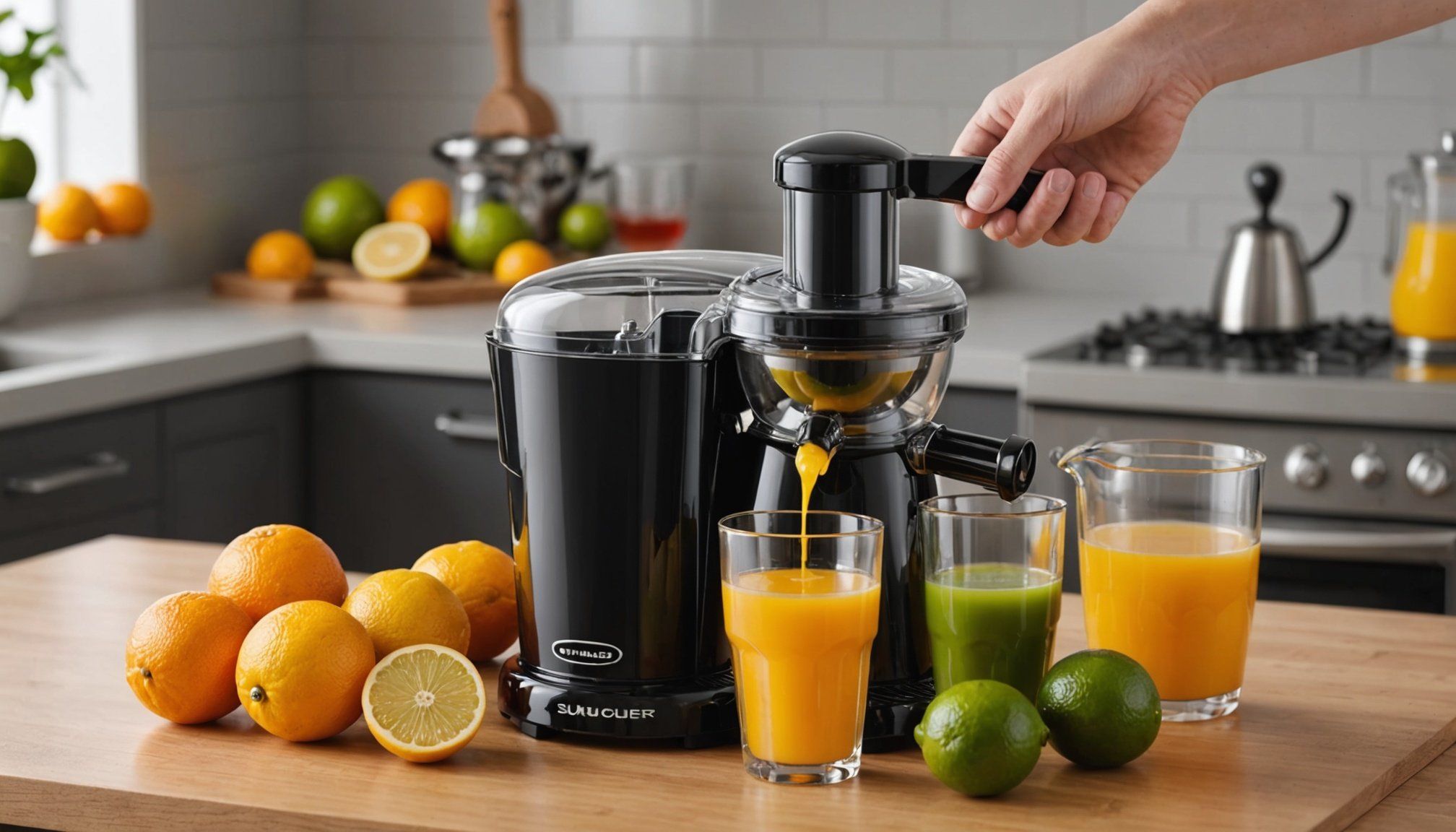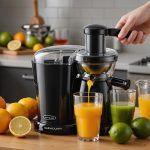Overview of Manual Citrus Juicers
Manual citrus juicers offer a traditional method for extracting juice from citrus fruits. These juicers are designed to exert pressure, efficiently extracting juice without the noise and complexity of electric models. Due to their simplicity and ease of use, manual juicers have become invaluable in kitchens that favour a hands-on approach.
Tracing Back: The evolution of citrus juicing tools dates back centuries, with early models crafted from wood or stone. Over time, these tools have become more refined, adopting ergonomic designs and durable materials. Today’s manual juicers strike a balance between aesthetics and functionality, featuring variations from simple handheld squeezers to the more elaborate lever-arm juicers.
Also to discover : Discover the Best Blade Material for Your Mandoline Slicer: Achieve Perfect Cuts Every Time!
In comparison to their electric counterparts, manual juicers offer a quieter operation. While less fast, they enable full control over the juice extraction process, allowing users to achieve the desired consistency and quantity. Manual options tend to be more compact, making them ideal for small kitchens or for those who prioritise a minimalist lifestyle.
When considering a manual citrus juicer, key aspects to consider include the ease of juice extraction efficacy, the suitability for different citrus fruits, and the ergonomic comfort during use.
Additional reading : Unlocking the perfect lobster feast: your ultimate guide to choosing the right stock pot size
Factors Affecting Juice Extraction Efficiency
The design of a manual juicer significantly impacts juice extraction efficiency. A well-engineered design can maximise juice yield by ensuring every drop is extracted with minimal effort. The manual juicer performance is influenced by elements such as the shape and material of the reaming surface. Sharply ridged, durable surfaces tend to grip the fruit pulp more effectively, yielding higher juice quantities.
Another key factor is citrus fruit selection. Different fruits offer varying juice yields; for instance, lemons and limes usually need less pressure but are smaller, while oranges require more robust juicers for optimal extraction. Tailoring your approach to the fruit type ensures the best results.
Techniques for maximising output involve applying consistent pressure and rotating the fruit correctly. Users can enhance efficiency by first rolling the fruit on a flat surface to break down internal fibres or slightly warming the fruit before juicing to loosen the juice pockets.
In essence, understanding and leveraging these factors can significantly boost the output and satisfaction of using manual juicers, making them a preferred choice for fresh juice enthusiasts.
Top Manual Citrus Juicers Reviewed
Exploring the best manual citrus juicers is essential for those seeking efficient juice extraction. These juicers are celebrated for their user ratings and effectiveness.
Juicer Model 1
This model is renowned for its robust build and superior juice yield. Key features include a wide reamer, making it ideal for large oranges. Users appreciate its ergonomic handle, enabling effortless pressing. However, some note the size may be cumbersome for smaller citrus fruits. Compared to similar models, it often outperforms in durability and juice yield.
Juicer Model 2
What sets this model apart is its compact design, perfect for small kitchens. It garners praise in product reviews for ease of storage while maintaining high juice extraction efficiency. Performance analysis highlights its strong grip on citrus pulp, despite its small size. Many users find it offers great value for money.
Juicer Model 3
Ease of use takes precedence, with intuitive assembly instructions. Constructed from high-quality stainless steel, it assures longevity. Users consistently rate it highly for ease of cleaning. Durability garners positive testimonials, making it a reliable choice. Satisfaction scores suggest it meets or exceeds user expectations in everyday scenarios.
Ease of Cleaning and Maintenance
When considering cleaning manual juicers, the material and design play critical roles. Stainless steel surfaces are favoured for their rust resistance and ability to withstand frequent use. Though not as lightweight as plastic, they endure the repetitive washing and the acidity of citrus acids better over time. On the other hand, plastic juicers are generally easier to handle, but may retain odours or stain with excessive use.
For maintaining manual juicers, a straightforward cleaning regimen is recommended. Disassembling the juicer allows for a thorough wash of each component, ensuring juice remnants do not lead to sticky build-up or blockages. Use warm soapy water and a soft brush to remove any stubborn pulp or seeds. Avoid abrasive scourers that might scratch surfaces.
User experiences reflect varied satisfaction levels with maintenance ease. Some users enjoy seamless cleaning when the components are dishwashable, while others prefer the hands-on approach for precision. Regular care of manual juicers not only simplifies future cleaning but prolongs the device’s longevity and ensures consistent efficient juice extraction over months or years. This maintenance insight serves both regular and occasional juicing needs.
User Testimonials and Experiences
User reviews indicate that manual citrus juicers enjoy a loyal following among fresh juice aficionados. Enthusiasts often commend the efficient juice extraction and simplicity these tools offer, attributing satisfaction to the hands-on experience of juice making.
Customer Feedback Highlights
-
Positive Aspects: Users frequently praise the ease of use and versatility of handheld juicers. Many note the minimalist design’s space-saving advantage and how it provides full control over extraction consistency. This empowerment translates into a remarkable juicing experience, resulting in tailored juice intensity.
-
Areas for Improvement: While customers appreciate simplicity, some express frustration over the effort manual juicing demands, particularly with larger fruits. Nonetheless, they often mention this as a small trade-off for achieving the desired consistency and flavour profiles.
Personal Juicing Stories
A recurring theme in customer stories is the joyful involvement in the juicing process. Regular users often describe making juice as a therapeutic ritual, valuing the tactile engagement. Others narrate using manual juicers for educational purposes, teaching children about preparing healthy juices.
In essence, manual juicers appeal broadly to those who relish personal involvement in healthy living, despite minor challenges requiring a bit of elbow grease.
Recommendations Based on Specific Needs
Choosing the right manual citrus juicer can depend greatly on your frequency of use and individual user needs. For those who enjoy fresh juice daily, investing in a durable, high-capacity model might be worthwhile. Such juicer recommendations are often directed towards models with strong user reviews highlighting longevity and efficient juice extraction.
Everyday Users: Look for juicers that are built to withstand regular use. Stainless steel options or heavy-duty lever-arm models often fit the bill, providing robust performance and ease of cleaning, even with repeated juicing.
Occasional Users: A more compact, handheld juicer might serve well. These models are typically affordable, easy to store, and perform adequately for sporadic usage. They offer a balance between efficiency and convenience, supporting leisurely juicing without demanding too much effort or space.
Lifestyle Considerations: If space-saving is a priority, consider a minimalist design. For households with children, models that are simple to use and clean may be preferable. Always align model choice with the types of citrus fruits you prefer, ensuring your selected juicer can handle your favourites efficiently without compromising on juice yield.








